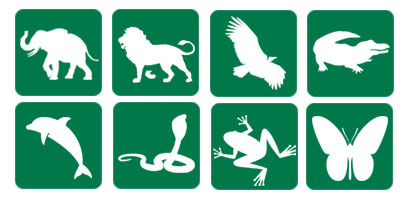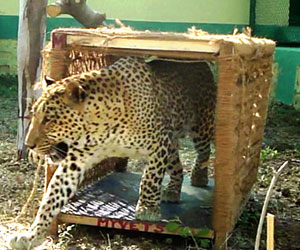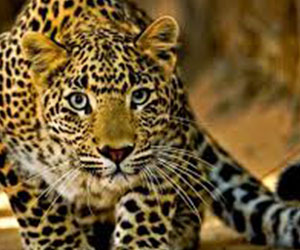The climatic changes and the over exploitation of the natural resources have resulted in the increase of the negative impact of invasive species and it was focused only on crises of conflicts, drought, famine and migration rather than root causes linked to the unsustainable use of natural resources. Similarly human development and demands on sustainability were only concerned about globalization, corporation and dominant political agenda.
SPECIES CONSERVATION PROGRAMME

All these activities have led to the disappearance of many species and even large numbers being brought close to extinction. Entire biomes are now endangered with biodiversity in some areas under so much pressure that complete ecosystems, in particular those with the greatest biological diversity are under threat.
INDIA, with 3287 million hectare of land mass, occupies 24% of world’s total area. India lies within Indomalaya Eco Zone and contains three biodiversity hot spots. One of 17 mega-diverse countries, it hosts 8.6% of all mammalian, 13.7% of all avian, 7.9% of all reptilian, 6% of all amphibian, 12.2% of all piscine, and 6.0% of all flowering plant species.
The total area under forest cover in India is 77.47 million hectare, which is 23.57% of the total land area. 606 Protected Areas comprising 96 national parks and 510 wildlife sanctuaries with overlapping of 28 tiger reserves and 25 elephant cover an area of 15.59 million hectare and making up about 4.58% of the total geographic area and 22.12% of total forest cover of the country. In addition to that; there are 150 recognized Zoological Parks having around 40,000 wild animals in captivity in the country.
The country stands out as a treasure trove of natural wealth despite countless obstacles to their conservation. Habitat loss has been due to serve biotic pressure, diversion of forest land for non-forestry purpose or illegal occupation, degradation of habitat, fragmentation of habitat. Problems are manifold.
There is an urgent need to conserve its forest and wildlife. The Government of India has always been sensitive to this and taken several initiatives towards preservation of forests and wildlife in the country from time to time.
Various management and conservation strategies are being framed by IUCN, WAZA, WZCS and which are followed. However, these strategies are not yet successfully implemented. Thus various strategies have to be framed by Myvets Wildlife Trust for successful implementation of conservation strategies for saving the endangered species of India. The research work by Myvets Wildlife Trust will support the whole spectrum of management and conservation, through in-situ breeding of threatened species, research, public educations, training, and influence, and advocacy. The research work has been already started; few articles on the wildlife management & conservation are published in various magazines.
Dr.Madhurita & Dr.Yuvraj Kaginkar ensures both the physical protection of individual species across the India as well as the conservation of core breeding and resting, nesting sites and regeneration of already functional ecosystem as well as the habitat is the key to conservation for certain particularly rare and threatened species under the Species Conservation Programme.
We aim to establish and implement the right protection regime for wildlife and reptile species listed threatened in the Habitats Directive through our programme we encourage wildlife conservation and sustainable use of biodiversity in India.
LEOPARDS
In 2014, Myvets Wildlife Trust together with the Sanjay Gandhi National Park began a project based on ecological and biomedical information for In-Situ conservation by Environmental Enrichment planning for the captive leopards wherein our Activities also included Captive Wild leopards and Bengal tigers surgery for the In-Grown Nails due to lack of activity inside the Rescue Centre to increase the healthy survival rates of the captive wildlife living inside the park. Captive Leopard Habitat Management is the key to healthy life of these rescued captive wild leopards of the SGNP.
Leopard – Human Conflict Mitigation near protected area is our community based initiative to prevent the conflicts with Education, Awareness & Technology. Our research team is working on these novel technologies which can play vital role in prevention of Leopard – Human Conflicts near National Parks.


CHIMPANZEE

Chimpanzees are critically endangered species and holds a ecological value in the ecosystem and gives us a understanding of human evolution at Myvets Wildlife Trust, Our Wildlife Vets have taken every necessary step for the conservation, protection of these species by providing them a better environment and wildlife veterinary healthcare.
Myvets Wildlife Trust Experts and Trustees carried out activities crucial to the conservation of chimpanzees by doing the Master planning of the enclosure for the endangered Chimpanzee species Enclosure by designing Environmental Enrichment of the Enclosure to exhibit their natural behaviour and to prevent the stereotypic behaviour.
The enclosure was designed keeping in mind all the needs of the species which was taken into account when designing an enclosure; such as their behaviour, reproduction, habitat, feeding, activity, ropes, trees, branches. This was a very Modern, innovative, ground breaking concept tried first time in India and it took care of the need of the species, welfare, safety and overall health factor.
CROCODILE
MYVETS WILDLIFE TRUST is committed to wildlife conservation, protection awareness and is appointed as an expert to tackle the increasing case of Crocodile – Human Conflicts in the region by using Modern Technologies and Scientific Strategy to deal with the long term management of Crocodile – Human Conflicts and to prevent the further casualty in that area. Conflicts between humans and wildlife, especially large carnivores such as crocodilians, are becoming a complex conservation challenge worldwide including India. Myvets Trust aims to provide prevention of Crocodile – Human Conflicts, improve safety measure for people living near river banks, creating awareness about the conflicts, study of vulnerable spots of crocodile – human conflicts, Gathering data/Census about the crocodile attacks and statistics in India as per the species of crocodilians.


PEACOCK

We are working to provide protection to Indian Pea Fowl species through our species conservation programme.
Peacock Species is becoming locally extinct from several areas due to habitat conversion, urbanization and disturbance in the food chain. There is much effort made in India to save and protect the National Animal, Tiger and many projects are underway whereas Peacock Conservation is neglected. At Myvets Trust, we are determined to protect and Conserve the National Bird, Species of Indian Peafowl which has an ecosystem balancing role to play, by using Scientific methods, Avian Veterinary management, Habitat Restoration & Scientific Ornithological Research. Indian Peafowl is a species of National importance and the population is declining due to the illegal trade across international borders for feathers, Mass Mortality due to use of pesticides in crops and for the wild peacock meat, Conflicts with farmers during cropping & hence poisoning, Habitat Degradation, Industrial Growth, Hunting for sport, Consumption of Eggs, Peacock Poaching, Peacock Fat Extracts for medicinal purpose all these has caused the recent alarming decline in the species of Peafowl population.
